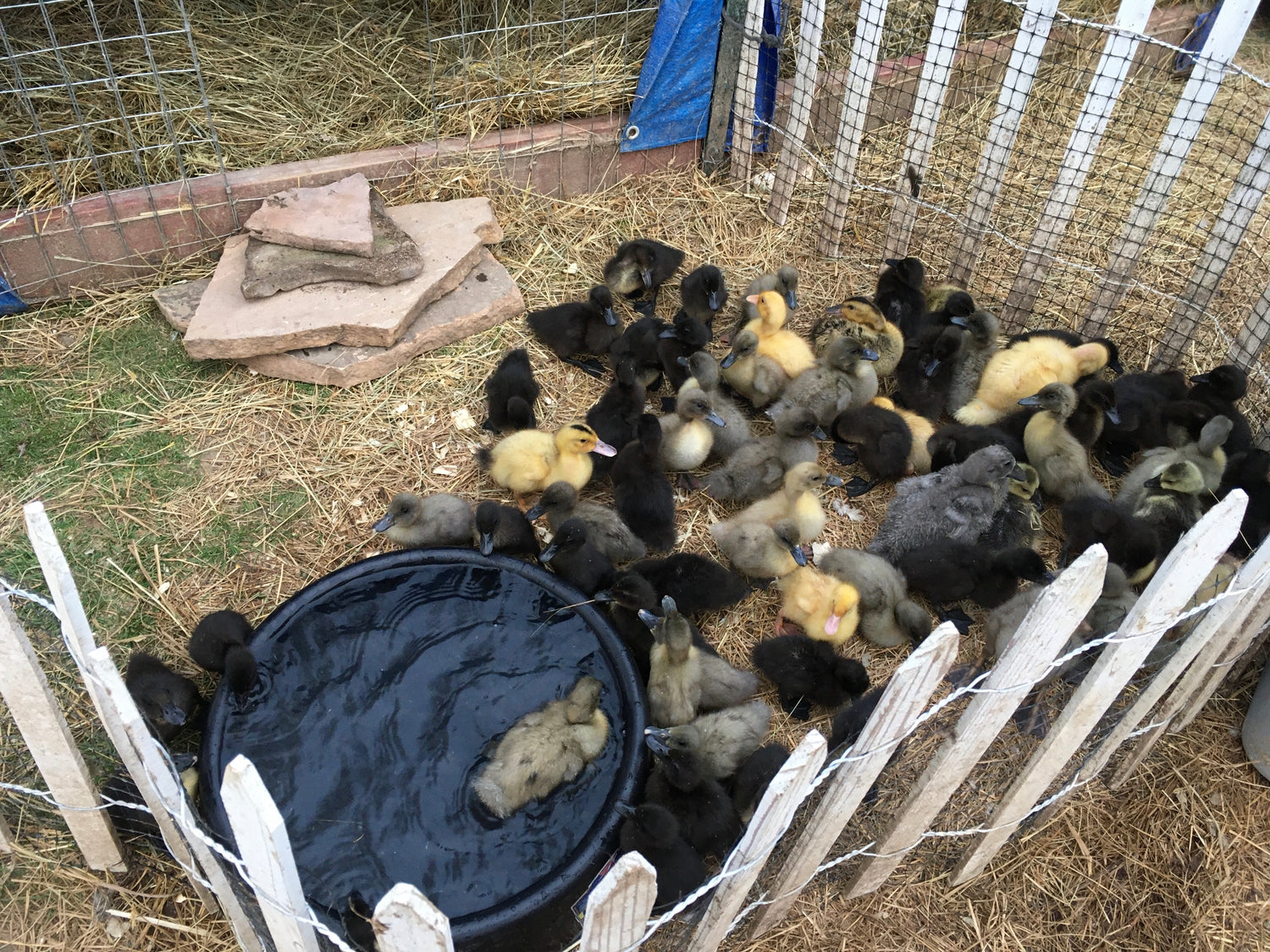All About Ducks!
Here is information about domestic ducks, exotics, native and imported waterfowl.
Domestic Duck Breeds
-

Dutch Hookbill
More About Dutch HookbillsHookbills have small, flighted bodies, with narrow hips and long legs. They have a distinctive downward curving bill of exceptionally long length, green eggs, a small head and are fully flighted. Due to a decline in popularity, limited genetic diversity combined with poor breeding, and the overall difficulty of hatching waterfowl, these birds are increasingly harder to find.
-

Cayuga
More About CayugaLarge full body birds are desirable, with thick heads and necks. Both sexes look similar having full green iridescent bodies, black bills, black tongues and black feet. Hens lay black or dark grey eggs and are very good mothers when allowed to nest. Older hens tend to get white feathering as they age, but it is undesirable in males and all juvenile birds.
-

Aylesbury
These birds are held in high esteem for their large size and unusual pink bill and pink skin color. Today, standard bred show specimans have a greater size and deep, pendulous keel that brushes the ground. These birds require a diet high in vitamin A and D3.
-

Saxony
More About SaxonyLarge birds with wide chests and bright orange coloring are especially desirable for breeders. The hens usually make good mothers when allowed to sit. Drakes have a deep blue head and dark chestnut body.
-

Silver Appleyard
More About AppleyardThese are active foragers and the best egg layers among heavyweight breeds. Hens make good mothers when allowed to sit a nest.
-

Exhibition Rouen
Rouen Breed StandardsThese ducks were variously called “Rhone,” for an area in southwest France, “Rohan,” for a Catholic Cardinal, “Roan,” a mixture of colors, and finally “Rouen,” for a town in north-central France.
-

Exhibition Pekin
This is a show bird, much larger in size than the commercial or hatchery variety. Really friendly with a docile temperament and big loose plumage. This breed makes and excellent pet and is among the worst foragers.
-

Campbell and Harlequin
Khaki Campbell, Welsh Harliquin and Dark Campbell are genetically identical birds with a single color mutation. Other color varieties include Abacot Ranger, Frost Ranger, Gold Harliquin, Overberg and bibbed. A good line will average 300 eggs per duck per year.
-

Magpie
Black-and-white,
Blue-and-white,
Dun-and-white,
Chocolate-and-white
-

Swedish
Blue, Black, Brown, Silver, Splash
Large bodies with symmetrical, well defined bibs are desirable. Blue birds should had a deep coloring with darker lacing.
-

Crested
-
Orpington Buff
Similar in conformation to the Cayuga, with a slightly longer body and bill. Many are significantly under standard weight, with short bills and excessively concave topline. Valuable birds are full size with long straight bills and heads suggestive of their runner heritage.
-

Muscovy
This species is native to Mexico and South America. The hens make excellent mothers, with eggs averaging 35 days to hatch. This is one of the largest wild duck species with many feral populations established. Show specimens have good conformation, textured facial caruncling, and dark lacing on the plumage.
-

Runner
More About RunnersRunners have a wine-bottle shape with long necks. An exhibition Runner is smooth, slender, and nearly vertical. The taller the bird and the longer and straighter the bill, the better. Runners need plenty of exercise and proper nutrition. Runners with good type are genetically willowy when well fed. They are among the best foragers.
-
Ancona
This breed was most likely developed from the same stock as Magpie. Ancona are bigger than Magpie, with their primary feature a distinctive broken plumage pattern. This is an excellent laying breed. The legs and feet are orange with black markings. Breeders with a patch of color under the eyes and broken patterns on the wings and chest provide the most varied ducklings.
Bantam Ducks
-

Call Ducks
-

East Indies
-

Snowy Mallard
-
Miniature Swedish
-
Miniature Appleyard

Raising Ducks
Do ducks needs a pond?
Can you eat the eggs?
Why did the ducklings disappear?
Can ducks get lice?
Are ducks friendly?
Our Domestic Geese
-

Brown Chinese
-

Saddleback Pomeranian
-

Giant African
-

Pilgrim
-
Buff Dewlap Toulouse
-
Roman Tufted
-

Sebastopol

Exotic Waterfowl
Primarily kept as ornamental birds in private aviaries and collections. These birds are beautiful to look at, have pleasant chatter and some species even whistle!
Exotic Ducks
Bahama Pintail, White Face Tree Duck, Mandarin, Wood Duck, Black Belly, Eytoni, Marble Teal, Ring Teal, Wood Duck, Silver Wood Duck
Shelducks
Ruddy, Paradise, Cape, Common, Radja, Australian
Exotic Goose
Barhead, Andean, Magellan, Egyptian, White Egyptian, Cereopsis, Emperor, Magpie, Barnacle, Red Breasted
Swans
Australian Black Swan
Trumper Swan
Mute Swan
-

Wood Ducks
-

Andean Geese
-

Egyptian Geese
-

Mandarin
This brightly colored duck originated in East Asia and Japan. There are several established feral populations around the world. A common ornamental in aviary collections, also available in a white variety.
-

White Face Tree Duck
Tree ducks are one of the few species that have not adapted to fully tuck their feet into their feathers. Their toes are especially susceptible to frostbite and extra care should be given to their aviaries in colder climates.
-

Bahama Pintail
A species of dabbling duck native to South American, both the male and female look similar with white cheeks and bright red marking on the bill. There is a silver variety.
-

Cape Barren Geese
Cereopsis
-

Black Belly Tree Duck
-

Australian Black Swan
-

Mute Swans
More About Swans -

Red Breasted Goose
-

Radja Shelduck
-

Barnacle Goose
-

Barhead Goose
-

Magellan Goose



































